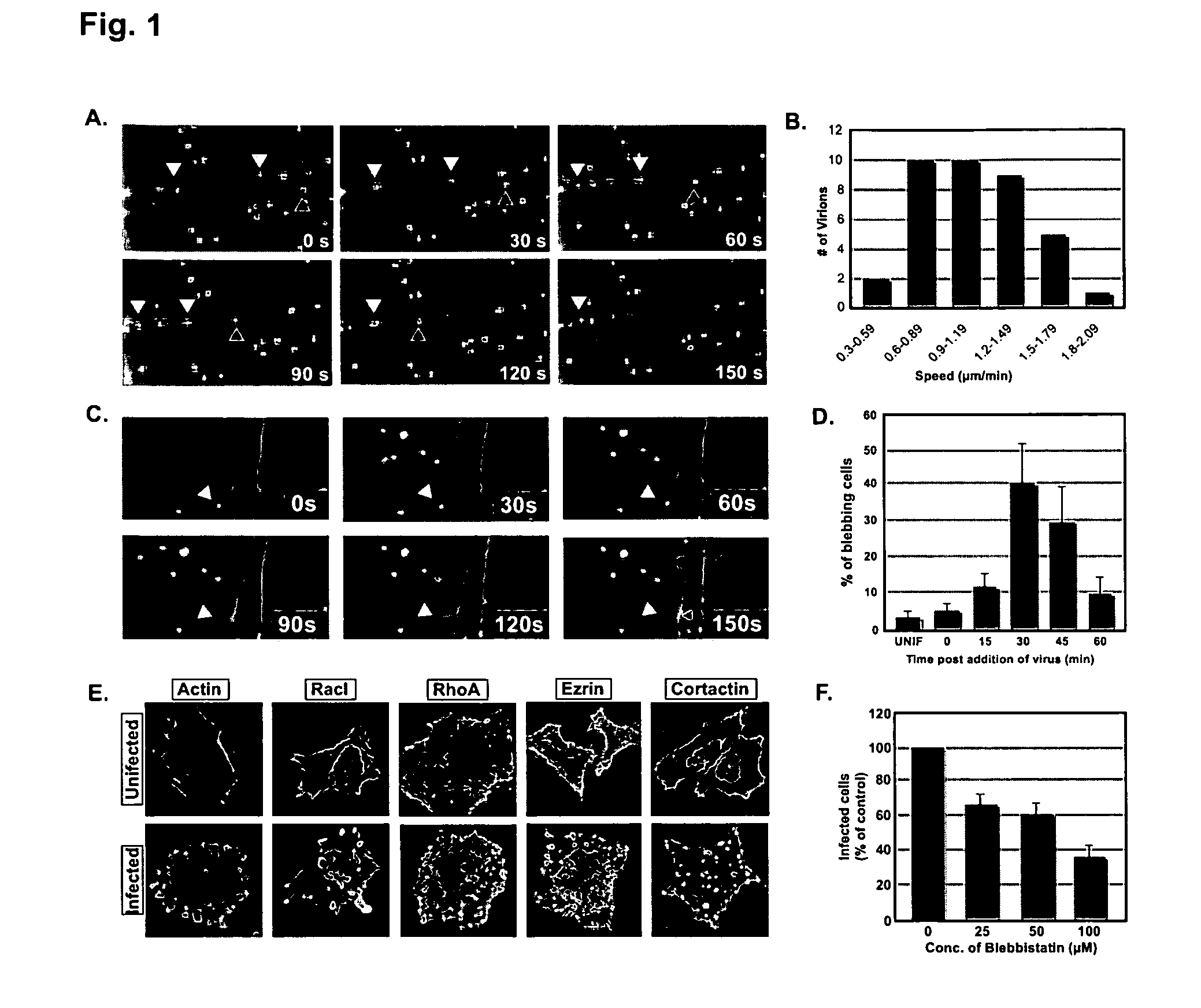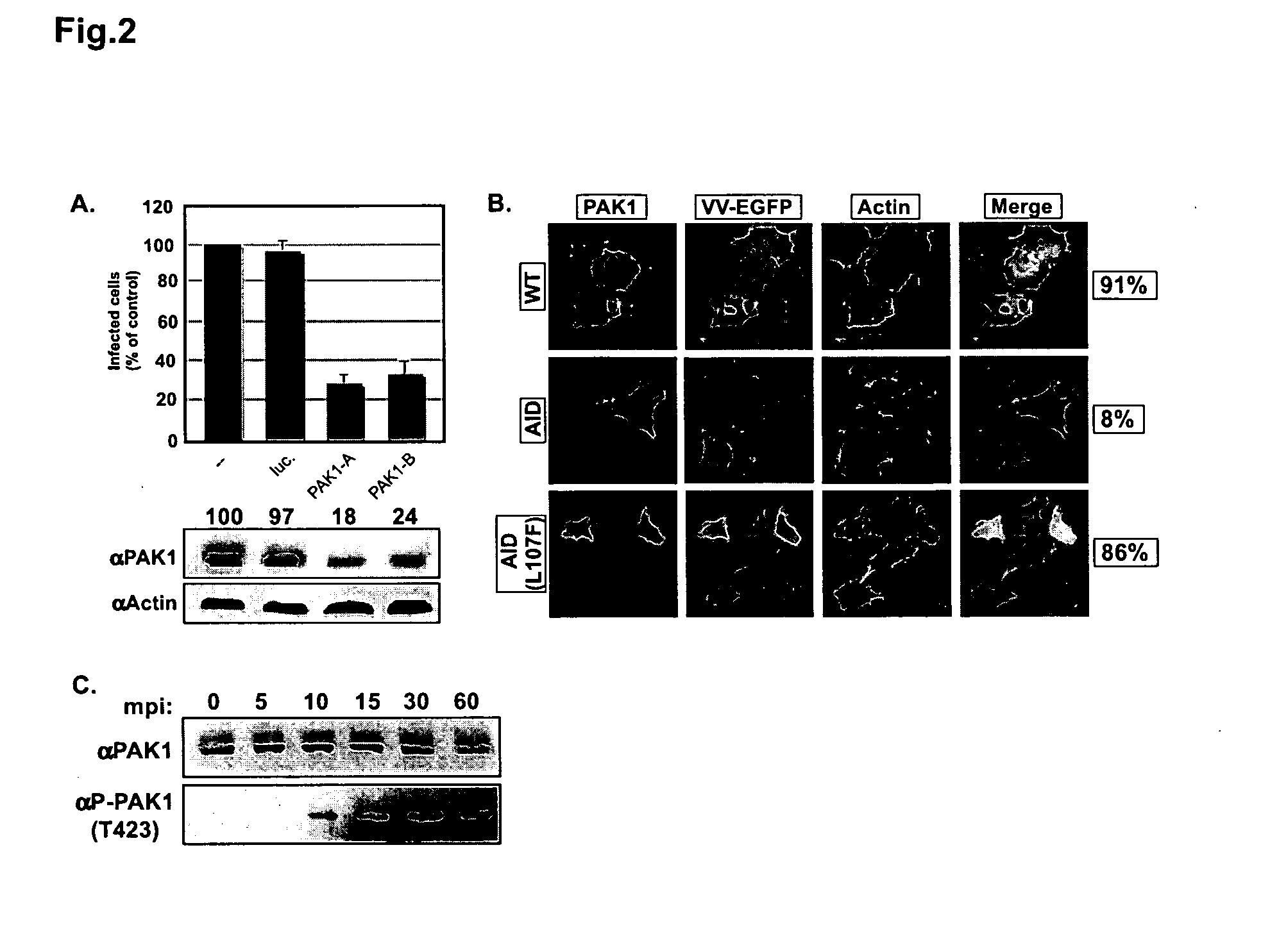Antivirals
a technology of antiviral agents and antiviral genes, applied in the field of antivirals, can solve the problems of reducing fitness and pathogenicity compared to wild-type, narrow spectrum of antiviral agents, and limited efficacy, and achieve the effect of inhibiting or reducing viral infections
- Summary
- Abstract
- Description
- Claims
- Application Information
AI Technical Summary
Benefits of technology
Problems solved by technology
Method used
Image
Examples
example one
Evaluation of Entry Mechanism of Vaccinia Virus
[0176]To study the entry of vaccinia virus into cells we first generated recombinant mature virus particles (MVs) in which one of the core proteins, A5, was tagged at its N-terminus with monomeric yellow fluorescent protein (mYFP-MV). When added to HeLa cells expressing EGFP-tagged actin, we observed many of the brightly fluorescent viruses bind to filopodia, and proceed to move (‘surf’), along the filopodia towards the cell body (FIG. 1A). The movement was generally smooth and uninterrupted with a rate approximating that of actin retrograde flow (˜1 μm / min; FIG. 1B). When the MVs reached the cell body, a dramatic change occurred: a large bleb extruded from the plasma membrane at the site of contact with the virus. The expansion lasted for 30+ / −4 sec, and the bleb remained extended for 10+ / −2 sec before it retracted with the virus (FIG. 1C). The blebbing peaked at 30 min after virus addition with 40% of cells showing one or more blebs (...
example two
Evaluation of Entry Mechanism of Adenovirus Serotype 3 Virus Materials & Methods
Cells and Viruses
[0196]Cells were grown in DME (GIBCO-BRL) containing 10% FCS (GIBCO-BRL) at low passage number as described (Suomalainen et al., 1999). Human melanoma M21 litter (negative for surface-expressed av integrins) and M21L cells (positive for cell surface αv integrins) were from Dr. D. Cheresh (Scripps Research Institute, La Jolla, Calif., Felding-Habermann et al., 1992). K562 chronic myelogenous leukemia cells were grown as described (Nagel et al., 2003). BHK cells stably expressing CD46 or CAR were produced by stably transfecting plasmids encoding either for the BC1 isoform of CD46 or CAR (Sirena et al., 2005). Ad3 and Ad2 ts1 were grown and isolated as described (Greber et al., 1996). Labeling of Ad3 with texas red was as published (Nakano and Greber, 2000). (3H)-thymidine-labeled Ad3 was produced as published (Greber et al., 1993).
cDNAs, Proteins and Chemicals
[0197]cDNAs encoding CtBP1-S / B...
example three
Role of EGFR During Viral Infection
[0205]The Rac1 effector, PAK1, is required for the entry of vaccinia mature virions (MVs), and the RhoA family GTPase Rac1 and RhoA are activated during the entry process (Mercer and Helenius (2008) Science 320:531-535). In turn, these GTPases can be activated by a variety of cell surface receptors (Schiller (2006) Cell Signal 18:1834-1843). Amongst these is the epidermal growth factor receptor (EGFR, Erb1). The involvement of the EGFR in vaccinia entry has been controversial (Marsh and Eppstein (1987) J Cell Biochem. 34:239-245; Eppstein et al. (1985) Nature 318:663-665; Hugin and Hauser (1994) J. Virol. 68:8409-8412).
[0206]An MV infection timecourse was used to assess the activation status of EGFR during vaccinia infection. EGFR activation was monitored using an antibody that recognizes EGFR phosphorylated at tyrosine 1173. EGFR was robustly activated within five minutes of virus addition, peaking at 15 minutes post infection (FIG. 7).
[0207]The E...
PUM
| Property | Measurement | Unit |
|---|---|---|
| diameter | aaaaa | aaaaa |
| diameter | aaaaa | aaaaa |
| diameter | aaaaa | aaaaa |
Abstract
Description
Claims
Application Information
 Login to View More
Login to View More - R&D
- Intellectual Property
- Life Sciences
- Materials
- Tech Scout
- Unparalleled Data Quality
- Higher Quality Content
- 60% Fewer Hallucinations
Browse by: Latest US Patents, China's latest patents, Technical Efficacy Thesaurus, Application Domain, Technology Topic, Popular Technical Reports.
© 2025 PatSnap. All rights reserved.Legal|Privacy policy|Modern Slavery Act Transparency Statement|Sitemap|About US| Contact US: help@patsnap.com



